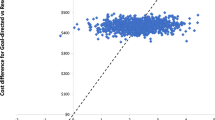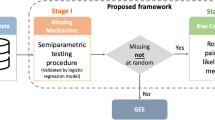Abstract
Background:
No studies report whether improvements to commercial weight-loss programs affect retention and weight loss. Similarly, no studies report whether enrolling in a program through work (with a corporate partner) affects retention and weight loss.
Objectives:
To determine whether: (1) adding evidence-based improvements to a commercial weight-loss program increased retention and weight loss, (2) enrolling in a program through work increased retention and weight loss and (3) whether increased weight loss was because of longer retention.
Design, Setting and Participants:
Data were collected on 60 164 adults who enrolled in Jenny Craig's Platinum Program over 1 year in 2001–2002. The program was subsequently renamed the Rewards Program and improved by increasing treatment personalization and including motivational interviewing. Data were then collected on 81 505 participants of the Rewards Program who enrolled during 2005 (2418 of these participants enrolled through their employer, but paid out-of-pocket).
Measurements:
Retention (participants were considered active until ⩾42 consecutive days were missed) and weight loss (percent of original body weight) from baseline to the last visit (data were evaluated through week 52) were determined.
Results:
Alpha was set at 0.001. Mean (95% confidence interval (CI)) retention (weeks) was significantly higher among Rewards (19.5 (19.4–19.6)) compared with Platinum (16.3 (16.2–16.4)) participants, and Rewards Corporate (25.9 (25.0–26.8)) compared with Noncorporate (21.9 (21.7–22.1)) participants. Modified intent-to-treat analyses indicated that mean (95% CI) percent weight loss was significantly larger among Rewards (6.36 (6.32–6.40)) compared with Platinum (5.45 (5.41–5.49)) participants, and Rewards Corporate (7.16 (6.92–7.40)) compared with Noncorporate (6.20 (6.16–6.24)) participants, with and without adjustment for baseline participant characteristics. In all cases, greater weight loss was secondary to longer retention.
Limitations:
The study was not a randomized controlled trial, rather, a translational effectiveness study.
Conclusions:
Improvements to a commercial program and enrolling through a corporate partner are associated with greater weight loss that is because of improved retention.
This is a preview of subscription content, access via your institution
Access options
Subscribe to this journal
Receive 12 print issues and online access
$259.00 per year
only $21.58 per issue
Buy this article
- Purchase on Springer Link
- Instant access to full article PDF
Prices may be subject to local taxes which are calculated during checkout







Similar content being viewed by others
References
Wang Y, Beydoun MA . The obesity epidemic in the United States—gender, age, socioeconomic, racial/ethnic, and geographic characteristics: a systematic review and meta-regression analysis. Epidemiol Rev 2007; 29: 6–28.
NHLBI. Clinical guidelines on the identification, evaluation, and treatment of overweight and obesity in adults—the evidence report. National Institutes of Health. Obes Res 1998; 6 (Suppl 2): 51S–209S.
Bish CL, Blanck HM, Serdula MK, Marcus M, Kohl HWI, Khan LK . Diet and physical activity behaviors among Americans trying to lose weight: 2000 Behavioral Risk Factor Surveillance System. Obesity (Silver Spring) 2008; 13: 596–607.
Hamilton M, Greenway F . Evaluating commercial weight loss programmes: an evolution in outcomes research. Obes Rev 2004; 5: 217–232.
Tsai AG, Wadden TA . Systematic review: an evaluation of major commercial weight loss programs in the United States. Ann Intern Med 2005; 142: 56–66.
Finley CE, Barlow CE, Greenway FL, Rock CL, Rolls BJ, Blair SN . Retention rates and weight loss in a commercial weight loss program. Int J Obes (Lond) 2007; 31: 292–298.
Pate RR, Pratt M, Blair SN, Haskell WL, Macera CA, Bouchard C et al. Physical activity and public health. A recommendation from the Centers for Disease Control and Prevention and the American College of Sports Medicine. J Am Med Assoc 1995; 273: 402–407.
U.S. Department of Health and Human Services. Physical Activity and Health: A Report of the Surgeon General. U.S. Department of Health and Human Services Centers for Disease Control and Prevention, National Center for Chronic Disease Prevention and Health Promotion: Atlanta, GA, USA, 1996.
Perri MG, McAdoo WG, McAllister DA, Lauer JB, Yancey DZ . Enhancing the efficacy of behavior therapy for obesity: effects of aerobic exercise and a multicomponent maintenance program. J Consult Clin Psychol 1986; 54: 670–675.
Perri MG, McAllister DA, Gange JJ, Jordan RC, McAdoo G, Nezu AM . Effects of four maintenance programs on the long-term management of obesity. J Consult Clin Psychol 1988; 56: 529–534.
Perri MG, Nezu AM, McKelvey WF, Shermer RL, Renjilian DA, Viegener BJ . Relapse prevention training and problem-solving therapy in the long-term management of obesity. J Consult Clin Psychol 2001; 69: 722–726.
Smith DE, Heckemeyer CM, Kratt PP, Mason DA . Motivational interviewing to improve adherence to a behavioral weight-control program for older obese women with NIDDM. A pilot study. Diabetes Care 1997; 20: 52–54.
West DS, DiLillo V, Bursac Z, Gore SA, Greene PG . Motivational interviewing improves weight loss in women with type 2 diabetes. Diabetes Care 2007; 30: 1081–1087.
Wadden TA, Butryn ML, Byrne KJ . Efficacy of lifestyle modification for long-term weight control. Obes Res 2004; 12 (Suppl): 151S–162S.
Wing RR, Pinto AM, Crane MM, Kumar R, Weinberg BM, Gorin AA . A statewide intervention reduces BMI in adults: Shape Up Rhode Island results. Obesity (Silver Spring) 2009; 17: 991–995.
Hamman RF, Wing RR, Edelstein SL, Lachin JM, Bray GA, Delahanty L et al. Effect of weight loss with lifestyle intervention on risk of diabetes. Diabetes Care 2006; 29: 2102–2107.
Martin CK, O’Neil PM, Pawlow L . Changes in food cravings during low-calorie and very-low-calorie diets. Obesity (Silver Spring) 2006; 14: 115–121.
Acknowledgements
C Martin receives funding from the National Institutes of Health (NIH) Grant nos K23 DK068052 and R03 DK083533, and NIH and National Science Foundation Grant no. R21 AG032231.
Author information
Authors and Affiliations
Corresponding author
Ethics declarations
Competing interests
In addition to the NIH grants listed in the acknowledgements section, C Martin receives honoraria for lectures from scientific, educational and lay groups, and he received partial reimbursement for travel expenses in the form of research funds totaling <$725 from Jenny Craig Inc. A Hymel is also funded by NIH grants. L Talamini and A Johnson are employed by Jenny Craig Inc. O Khavjou is employed by an independent research company.
Rights and permissions
About this article
Cite this article
Martin, C., Talamini, L., Johnson, A. et al. Weight loss and retention in a commercial weight-loss program and the effect of corporate partnership. Int J Obes 34, 742–750 (2010). https://doi.org/10.1038/ijo.2009.276
Received:
Revised:
Accepted:
Published:
Issue Date:
DOI: https://doi.org/10.1038/ijo.2009.276
Keywords
This article is cited by
-
Effects of weight loss intervention on body composition and blood pressure among overweight and obese women: findings from the MyBFF@home study
BMC Women's Health (2018)
-
The Transition into Young Adulthood: a Critical Period for Weight Control
Current Diabetes Reports (2017)
-
Factors associated with participant retention in a clinical, intensive, behavioral weight management program
BMC Obesity (2015)
-
Evaluation of the Effectiveness of Making Weight Watchers Available to Tennessee Medicaid (TennCare) Recipients
Journal of General Internal Medicine (2013)
-
Predictors of Attrition in Bariatric Aftercare: A Systematic Review of the Literature
Obesity Surgery (2012)



